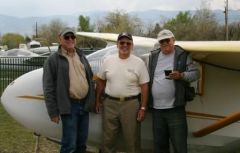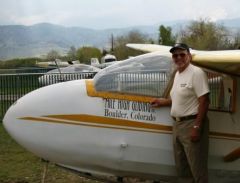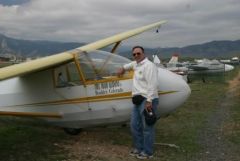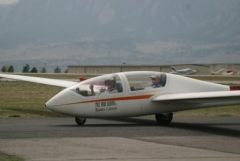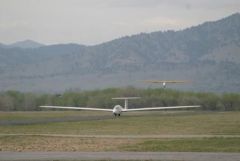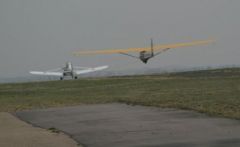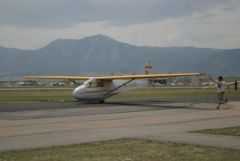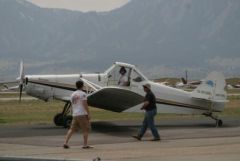-
Content Count
2713 -
Joined
-
Last visited
-
Days Won
44
Content Type
Profiles
Forums
Blogs
Gallery
Everything posted by tbutler
-

Do you travel the same route back and forth?
tbutler replied to tbutler's question in Destinations/Attractions
Gary, Thanks for your comment. I think it is interesting the different ways that people plan their travels. That is one of the reasons I put up the topic about people completing their data so we can look them up and find out more about them, their interests and preferences. I thought it would help all of us in giving information to help others if we know how they like to plan things. I don't disagree with you about using the interstates when needing to get somewhere but most of the areas I mentioned above are well away from the interstate highway system. I tend to try to find campgrounds near where we will be touring as we usually like to stay for several days and get a good look at some specific interest. In this case as always, I'll use the toad for those places that are way off the route but if as in this case, we can string together a group of interesting sites along a route of travel then we'll try to camp as close as possible to the site. In the case above, we were going to travel this distance anyway and this relieved the boredom of driving the same road one more time! When we travel, I am less interested in the campground, we don't spend a lot of time there. I want to minimize my travel time to and from the feature we are interested in and maximize my time exploring new territory. I have a strong preference for seeing new country and don't mind (in fact I enjoy) a slower rate of travel especially if the roads are lightly traveled. We sometimes will string together a series of stops along a route of travel and make each stop in the motor home and then continue to our campground rather than stopping only at the campground and backtracking with the toad. Personal preferences, not necessarily the right answer for everyone. -

Driver licensing - S.C. and other states
tbutler replied to tmoning's topic in Laws and Legislative Action
I investigated this subject carefully before we selected South Dakota as a home state. Still, I wanted further clarification just to make sure I was fully legal. The way that I read this reply suggests that those who are work campers may want to contact an attorney if registered in South Dakota or other states. I would think this would be especially true if you deduct any of your RV Expenses on your Federal Form 1040 as a business expense. Be sure to give them all pertinent information. They may assume the weight of the motor home or assume that it is purely recreational. The reply you get may not be correct if you haven't given all the information you think might be related to this decision. As you can see, I filed this information away for future reference. Here is the reply I got by to my query, which is below the reply: Thank you for your correspondence. You are not required to have a commercial license to drive the motor home, as long as you use it for recreational purposes only. If you have any other questions, please let me know. Jenni Driver Licensing 800-952-3696 -----Original Message----- From: Tom Butler [mailto:2tmb@earthlink.net] Posted At: Saturday, March 04, 2006 11:23 PM Posted To: DPS Licensing Info Conversation: Clarification of Driver Licensing for Driving a Recreational Vehicle Subject: Clarification of Driver Licensing for Driving a Recreational Vehicle I can find no specific reference to driving a recreational vehicle in the drivers licensing information. I inquired verbally when obtaining my SD drivers license in 2001 but since then have taken a safety course in which they advised us to ask specifically about our specific situation. My wife and I drive a Monaco Windsor Motor Home, GVWR of 37,600 pounds and a GCWR of 47,600 pounds. This is a diesel powered motor home with air brakes. This is not a commercial vehicle. When we inquired in 2001 we were told that a regular drivers license would be sufficient for driving our motor home. We did not specify the GVWR or GCWR at the time we asked the question. Is this information correct or should I obtain a commercial drivers license to legally drive my motor home? My license is up for renewal in August 2006 and I plan to renew in April before leaving for Alaska for the summer so need clarification on this issue. Thank you, Tom Butler -
We have been full timers for 7+ years. With family in Valley Springs, California (south of Sacramento), Denver, Colorado and St. Louis, Missouri, we wear ruts in I-80 and I-70 visiting family. In the fall of '07 I finally said, "We're going to vary our route." From Valley Springs we usually take CA 88 to the Nevada border, then through Carson City and east on US 50 and Alternate 50 to link up with I-80. We stop in Winnemucca at the Wal-Mart and fuel up at Flying J there as well. The second day we drove to Wells and then took off to the north on US 93. In southern Idaho is Craters of the Moon National Monument. There are vast lava fields with many lava caves that can be explored. We climbed cinder cones, enjoyed exploring lava caves and hiked several trails within the park. We stayed at a very nice campground, Landing Zone RV in Arco, Idaho. There is a campground in the National Monument but I don't think they had full hookups. From there we continued on east to Grand Teton National Park. We stayed at the campground at Coulter Bay Village in the park for one week. It was the end of the season and we had no trouble getting a spot. We were a short walk through the woods to Jackson Lake and enjoyed walking the shore at sunset, looking at the Tetons across the lake. We drove to the Gros Ventre slide one day. This is a rather famous collapse of a mountainside that occurred in 1925. The scar and the jumbled rock and debris are still evident today and you can walk through the debris field right up to the lake that still remains where the slide blocked the Gros Ventre River. Another day we took a canoe out on Jackson Lake and enjoyed seeing Osprey and Bald Eagles as well as the spectacular view of the Tetons across the lake. We hiked up into the mountains to some of the small lakes formed on glacial moraines and had a nice view of Jackson. We took a horseback ride at a ranch outside the park one day. One day we went to the Grand Teton Lodge. It happened to be when there was a Federal Reserve Meeting at the lodge. We walked in on a media blitz complete with all the financial news people, print, radio and TV. I was outside looking for moose in the meadow below the lodge when I looked to the over to a gathering of people on a patio outside a meeting room and there was Ben Bernanke, Chairman of the Federal Reserve! You just never know what you will see when looking for a moose! From Grand Teton National Park we drove southeast, crossing I-80 and continuing on south to Flaming Gorge Canyon and Dam. We traveled on into Vernal Utah and camped at Fossil Valley RV. We returned to Flaming Gorge for a full day of exploring the scenery and history of the area. We spent some time at the visitors center at the Dam on the Green River. There is a great drive that runs through some absolutely weird geology on the western side of the gorge. The whole area is dinosaur country and we spent a day at the Dinosaur Museum in Vernal. This is a very nice museum, if you are traveling with children, they will love it. We were planning to stop at the quarry in Dinosaur National Monument and were distressed to find that the building covering the quarry had been condemned and couldn't be replaced until Congress authorized the destruction of the old historic/unique architecture building since it was itself a monument. We were glad to hear that the current stimulus package passed by Congress included money for a replacement building at the quarry. In a year or two, this spectacular display of dinosaur bones partially excavated and exposed in the quarry wall will once again be accessible to the public. We finished our trip to Denver by taking US 40 across western Colorado in what was a beautiful drive on a little traveled road. We stayed overnight in Granby, Colorado. In the morning we tackled Rabbit Ears Pass and then the steep descent into Denver on US 40 and I-70. The scenery along this stretch was spectacular. We had been cautioned to take an alternate route but we were glad we persisted and saw this part of the Rocky Mountains. This was a two week adventure bypassing a stretch of I-80 that we usually do in two or three days. The adventure of traveling new roads and seeing new scenery made this a very refreshing side trip. We're planning to do the same along other stretches of this frequently traveled route in the future.
-
Under General Discussion is an account of a trip we took with our grandson and family when he was just 4 years old. Ryan and his cousin Spencer are now 9 and 8 years old and we are preparing to take them on a 12 day tour within about a day's drive of home. We have progressed from the grandparents that live in the "school bus" to the grandparents who do the neatest things with our grandchildren. Our oldest daughter and her husband put in a pad and utilities for us to stay at their house. We paid the cost, they gave us the space. Our grandson and granddaughter love to see us show up. We'll babysit for them about half the time in the motor home. My son has a daughter and son. We visit them when we are in the neighborhood. My son is planning to move and build a home, we'll make him the same deal if he is interested. Both these children are in the St. Louis area. We also have a daughter in California with two girls, 5 and 2. We go west each year to visit them and stay for three weeks to a month. There are no campgrounds near them (20 miles is closest) but we go spend the day with the youngest and stay to fix dinner for mom and dad when they get home. At other times, we're on our own. As the children get older, we have dozens of places we would like to take them. Rather than driving across country, the older children can be put on an airplane by their parents and met at the airplane by grandpa and grandma. They can stay a week or a month, whatever they (or you) can tolerate. I read an account in a book before we were going full time that mentioned having the grandchildren stay with them when they volunteered at a National Park. They ended up being in a drama presentation each day and learned a tremendous amount about history and acting. There are dozens of ways that we can relate to our families. We are currently in Denver taking care of my wife's mother who was in the hospital several weeks ago. She stays with my wife's youngest sister and her husband. They both work and couldn't take care of Mom without taking off work. So we are able to assist them and keep Mom at home through her recovery. We helped Mom move from Lake Havasu to Denver when she was no longer able to drive. We parked next to her house, cleaned out the house, packed the moving van and took her to Denver in the motor home. We do the same for my mother. We stay several weeks in her driveway, she has her to-do list and I work my way through her list. I spend more time with my mother now than when I was living just 50 miles away. We correspond with our children and grandchildren regularly by e-mail and occasionally send pictures. As the grandchildren have gotten older, we are able to talk to them on the telephone. There is no way we could be there for all of our family like we are now.
-
Sounds like you'll be taking a northern trek across the country going west. Doing this in 25 days sounds like a lot of driving but here are a few of the things I wouldn't miss. The Badlands of South Dakota are just east of Mount Rushmore. You could drive through there on your way. There is an exit for the Badlands on the eastern end of the park and another on the western end of the park. So you could drive through and not extend your trip by too much distance. It will be a slow drive but we have done it in our rig. Most parking lots are drive through so you can pull through them and back onto the main road. There is only one main road through. Best seen in early morning light or late evening but quite scenic in any light. Be aware that the July-August temperature can be really hot in mid-day! We were through there several years ago when there were thunderstorms in the distance, quite spectacular. The western access to I-80 is at the town of Wall which has a rather famous drug store. This is typical of the highway curiousity of the 1950's. Even the kids may get a kick out of some of the stuff there! Besides you'll need the free ice water! I wouldn't miss Yellowstone NP, too much to see here in a lifetime. Glacier NP is a little north but worth your stop if what you want to see is scenery. You won't see any glaciers in Glacier NP, its name comes from the glacial features that make it so spectacular. You might luck into seeing a Grizzly Bear! In the northwest, Oregon and Washington, Mount Rainier is great scenery. Going south take a look at Crater Lake, a brilliant blue lake in a collapsed volcano. Going south on I-5 through Oregon and northern California you will pass a number of scenic volcanoes. Go west to the coast to see the west coast of Oregon and northern California. The Redwoods are along the coast and the best places to see them are to drive the Old Redwood Highway. It passes Redwood State Park and you can walk trails among the Redwoods. You have to see the redwoods. Even your teenagers will be awed at these monsters. San Francisco is a great city to visit. We stayed at the RV park at Candlestick Park several years ago. From there you can tour the city, see the Golden Gate Bridge, Fisherman's Wharf, tour Alcatraz. Drive through some of the hills in and around San Francisco and see how they build houses in California! There are places along the coast north and south of San Francisco where you can see wildlife. Seals and Sea Lions in the wild. We love the aquarium at Monterrey. The old cannery town has a certain charm. East of San Francisco is California Gold Country. The town of Columbia, California is a state park with all the old buildings and historic tours. You can pan for gold. We stayed at a park near there, can't remember the name, they even had a gold miner on the property working a stake on the hillside! The town of San Andreas, California is the home of the jumping frog contest of Mark Twain fame. The sidewalks have brass panels to commemorate each years winner! Don't tell the kids but there are some great wineries in this area. Murphy just up the road has many shops and stores and numerous wine shops. Of course if wine is your thing, the Napa Valley is north of San Francisco. There are over 100 wineries in the Napa Valley. On to the south of the gold country is the not-to-be-missed Yosemite NP and more giant trees at Sequoia National Park. Stay out of Death Valley in July and August! Great in winter, early spring or late fall but you could be caught dead in the middle of the summer! There are other desert areas to explore but all will be quite uncomfortable in the summer heat. LA has all the big city stuff plus Hollywood and Disneyland. Palm Springs is interesting. San Diego has the Navy Yards. On the way back, not far from Death Valley is Las Vegas. Or if you go further north, Reno. Both offer lots of entertainment, some of which is suitable for the teens. I-80 across Nevada is mostly desert and not much else to see. Every truck stop and grocery store will have slot machines! In Utah, you will pass the Bonenville Salt Flats on I-80 and then it is right into Salt Lake City. If you can drive through town to see the Morman Temple. The drive up I-80 east of Salt Lake is a good up hill run but this offers the best way back across the Rocky Mountains through Wyoming. I-70 coming out of Las Vegas will give you some real mountain driving through Colorado and the scenery can't be beat so that is an alternate route. Cheyenne and Denver offer different looks at large western cities. Across southern Kansas you can stop at Boot Hill in Dodge City, KS. Southern Missouri has Branson with it's large entertainment area but most of these entertainers are foreign to your teenagers. See the zoo in St. Louis and take a trip up the Gateway Arch in the Western Expansion Museum. If you have been through Ohio, try Kentucky or Tennessee. Memphis has Elvis and a pyramid along with a great model of the Mississippi River in a park along the river. Louisville and Nashville have horses and music. The Grand Old Oprey Hotel is an eye opening experience. You can't begin to see all of this but I offer these as some suggestions to consider depending on your interest.
-
Great service! I thought maybe I had broken something! Not really but it did have me confused as to what the problem was. I checked it this afternoon and it was working fine. Thanks.
-

Wouldn't it be nice if everyone filled in their signature?
tbutler replied to tbutler's topic in Forum Support
And it goes beyond the equipment! I just responded to richardingle, who had a query about places to go in New England. I sent a response but I have no idea what their interests are. Do they like to fish, hike, bicycle, see scenery, take boat tours, visit museums or just hang around in a beautiful place and go to restaurants for dinner in the evening? The more we know about you, the better we can answer your queries. That includes some indication of age and how you like to relax. If Richard or his spouse is interested in antiques, my answer gave no help! -

East Coast motorhome trip
tbutler replied to richardingle@comcast.net's question in Destinations/Attractions
If you haven't seen New England, the coast of Maine has some beautiful sights. It should be cool and there are beautiful campgrounds with views of the coast. We stayed at one just north of Pemiquid with very nice facilities, Saltwater Farm Campground. Further north is Acadia National Park. We stayed at a campground near there, Hospitality Woods. Up near the border with Canada is Hilltop Campground. We stayed there and made final preparations to go into Canada (had to kill a couple of bottles of wine). Beautiful hilltop views there. We visited Eastport (almost the easternmost point in the US (there is a chip of land - island just a little further east). We looked at some land to buy near Eastport - dreaming about a summer place to park our RV with a view of the sea! As you get into this area, you will begin to see some tides that will drop your jaw if you think of tides as being what you see in Florida! This is the gateway to the Bay of Fundy which has the worlds highest tides. Off the coast near Eastport, ME is the summer "cottage" of the Roosevelt family (Franklin not TR). Campobello is in Canada but is accessed from the US via a short bridge and a beautiful place to be seen. We explored all the way to the lighthouse at the eastern end of Campobello, even climbing down and walking on the sea floor to get to the light house. Don't stay too long or you will have to wait a while to get back (or swim). On into Canada, New Brunswick has several great attractions. Put your motor home on the "big" ferry and go to Grand Manan Island. We have friends there that do whale watching trips (Whales and Sails) on a sailboat. You will get a good look at whales with any luck. We stayed at , I'm not kidding, Hole in the Wall Campground which is just a few blocks from the ferry. There are lighthouses and quaint villages to be explored. We took a ferry to Whitehead Island from Grand Manan taking only our bicycles. We rode the entire road around Whitehead Island (it isn't that long). There is a nicer campground on Grand Manan but I don't have the name. It is about 8 miles east of the ferry, only one main road! Back to New Brunswick via the ferry and on to Fundy National Park. We got a nice RV spot right in the park. Great trails and plenty of scenery. On east along the coast brings you to The Hopewell Rocks. Here the tides vary by about 30 feet from low to high tide and you can walk the sea floor around formations known as "Flower Pots." Or if you prefer, you can kayak around the flower pots at high tide. Nova Scotia has Halifax, well worth a week or so. At Truro you can watch the tidal bore come racing up river (this can be seen in a smaller scale in St. John and in some spots along the Maine coast as well. The best place we found for tides was at Burncoat Lighthouse on the north shore of Nova Scotia to the west of Truro. There you can walk thousands of feet out on the rocky ocean floor at low tide. Walk all around an island a low tide and see it as an island from the lighthouse at high tide. The attendant at the lighthouse will talk your ear off if you ask about the tides. A genuine delight! The eastern end of Nova Scotia is the incredibly beautiful Cape Breton. We toured the island in our motor home. Be prepared for some rough roads. Patience will serve you well here when driving but all these roads are traveled by commercial buses. We stayed at several campgrounds in Cape Breton National Park. Great hiking and scenery. There is a coal mine museum at Glace Bay. You can tour a 1930's coal mine and hear tales of the miners who mined coal under the sea! Tour the mine village and see where miners lived and ate. Eat at the miners cafeteria! Across town is the site where Marconi transmitted the first wireless message across the Atlantic Ocean! Well worth seeing. Not far away is the Alexander Graham Bell National Historic Site at Baddock. We stayed at the Arm of Gold Campground to tour these last few places. This is also the place to meet the ferry to Newfoundland if you really want to get away from it all! We're planning to take that ferry this summer. Perhaps we'll see you there. There is also a ferry directly back to the US from Yarmouth on the western end of Nova Scotia if you want to take the short cut home. I haven't mentioned the gems we found along the way like the single malt whiskey distillery tour on our way to Cape Breton. Great tour and great single malt whiskey (can't call it Scotch if it doesn't come from Scotland!) There are numerous museums including the Provincial Museum in St. John, New Brunswick. We also took the ferry to Prince Edward Island (PEI) and rode some bicycle trails there. We left PEI via the Confederation Bridge. The weather will be cool and the experience will be something you remember. You didn't mention if you fish, if so, there are places to fish everywhere. The lobster industry is fascinating to see and of course you'll get great Lobster at ridiculous prices. Ask the natives for the best spots to eat because you likely wouldn't go into some of these places if you relied on your first impression! If going to Canada, bone up on the regulations, liquor, guns and tobacco are hot topics. You'll need a passport for ease of passage. Investigate flight prices for your return trip to Florida, you may want to return to the US and fly from Bangor, ME instead of flying from somewhere in Canada. -
For those new and some not so new to the forum, I suggest that you go to MY CONTROLS and enter some basic information about your coach before posting a problem and asking for a solution. Knowing that information can be helpful to those making suggestions for solving your problem. The more we know the better the answer will be.
-
Try it and see! In our coach, all the outlets work. The inverter won't run some appliances. It runs the coffee maker but that puts a real load on the inverter and thus the batteries. In fact anything that generates heat from electricity like small electric heaters consume large amounts of electric. The inverter won't run the air conditioners, the washing machine or possibly the microwave. After a night of boondocking on a cold night with the furnace running our batteries will be pretty run down. I'll start the generator to recharge them and then make coffee while the generator is running and recharging the batteries. If Louise wants the microwave for making breakfast I'll leave the generator on for that. Our inverter has a battery charging sensor and it is set to shut off the generator when the batteries are fully charged. I'll usually let the generator run to automatic shut off meaning that the batteries are then fully charged for the coming day. If we are going to be plugging in early in the day, I'll leave the batteries partially charged and wait to plug in to finish the job. Your husband is correct that the inverter will run the batteries down. How fast depends on how many things you have running and the number and condition of your batteries. The inverter should be connected to your house batteries. If it were connected to your engine batteries, then running batteries down would be really bad. If you are using the dash 12V outlet to run your computer, that is probably running off the engine batteries. Running down the house batteries is what they are there for. You can recharge them by plugging in later in the day or by running the generator. In both cases the charger function of the inverter is changing 110V electric to 12V current to charge the batteries. If you are worried about running down the batteries, simply make sure that most electrical loads at the outlets are turned off. A laptop, a couple of alarm clocks, even an occasional TV program shouldn't drain the batteries in a day. Of course your house batteries run things like the controls on the refrigerator and hot water heater and also operate the furnace so you want to be sure you have enough charge to operate those essential services. As I said, try it out to see if it will meet your needs. We find using the inverter a real convenience that makes living in the motor home more comfortable.
-
In 2006 we traveled to Alaska and spent the whole summer on the journey. When we arrived in Fairbanks I was working on the motor home and then realized it was 11 p.m. I had to force myself to give up the work and go inside to sleep! I also had to laugh at myself. It is hard to realize how daylight affects us. I wasn't tired at all. I'm sure it would have caught up with me eventually. One of the things we saw in Alaska were numerous RVs with aluminum foil on their bedroom windows! I would imagine the bedroom was like a cave all the time. We used removable foam core board purchased at Wal-Mart to darken our bedroom. We had purchased it in 2001 when we moved into the motor home full-time. Cut to the height of our bedroom window and overlapped to accommodate the width of the panels, they are very effective room-darkening shades. Our first RV didn't have good room-darkening shades. Our present one has much better shades. Still, they weren't made for sleeping in the Alaska daylight that passes for night. These panels are found in the art department and come in a variety of colors. If you want dark, the black panels are best. Three of them take care of the large window in our bedroom and an additional one cut to size covers the small window. They are easily stored next to a cabinet during the day or under the bed when not needed for a period of time. We had transferred ours from our first RV and never used them until we got to Alaska. Then we dug them out from under the bed and put them to work. I like having something removable so the bedroom is bright during the day and really dark at night. We still use them when we are boondocking on a brightly lit parking lot. I hate the glimmer of a parking lot light twinkling through a string hole in the darkening shades when I am trying to sleep.
-
I like to read a newspaper and of course that isn't compatible with full-time travel. I'm sure many of you have found online newspapers that you like to read. If you haven't done so and would like to do so, read on. Many newspapers are available online at no charge. Sometimes there is a charge for selected sections or premium articles, etc. The New York Times is my chosen paper. I am signed up as a regular e-mail recipient. What I get in my e-mail each morning is the headlines from the sections of the paper I am interested in and choose to receive. If I click on an article, I get the full contents of the article. I am signed up for several special articles (also at no charge), one on technology and the other on travel. A recent article on the travel section was titled "Taking Your Home With You" and was about a Canadian couple who have a web site, www.frugal-rv-travel.com. They did an excellent job of describing the RV lifestyle. Not full timers, they travel in a Class B and their specialty is frugality! Anyway if you want to read the article it can be found at: http://frugaltraveler.blogs.nytimes.com/20...-home-with-you/ You might find the comments with the article interesting as they represent our friends and those who see us in an unfavorable light. I have added my comments and perhaps you would like to as well. You will likely have to sign up to read and certainly to comment on the article.
-
We have Motor Coach Design's (MCD) http://www.mcdinnovations.com/ sun screens all around. We are full time and having the screens on all the windows really helps in warm sunny climates. As Gramps mentioned, the MCD screens are attached at the top with a snap. The bottom of the screen has Velcro tabs that snap on the motor home and then attach to the Velcro corners on the screens. The advantage of this arrangement is that all screens will eventually stretch and even a little stretch causes the screens to sag. With the Velcro you can just pull them snug at the Velcro corners and keep them looking nice and tight. We winter in south Texas and with near constant windy days in the 20's and occasional days in the 30's or 40's I have seldom have a screen come loose so the Velcro tabs do the job. We have had the screens on the front since we bought the coach in November 1993 and use them for at least 5 months straight in the winter and occasionally in the summer as needed. Check the web site or call them to see if they have screens for your coach. We had custom screens made for all our windows so I'm sure they could do custom screens also. MCD has been really good about replacing needed parts. I have had a few of the snap tabs with Velcro that separated from the plastic backing they are on and they replaced the tabs at no charge. We even stopped and stayed overnight at their factory in McKinney, Texas (800-804-1757) just north of Dallas and had full hook-ups. You will find cheaper sun screens but not better ones!
-

Booster modem and antenna improves Wi-Fi reception
tbutler replied to tbutler's topic in RV Internet to Go/Staying in Touch
Yes, it has Vista drivers. I am using it with Vista right now. As I mentioned this one came with a small three inch antenna and we ordered a 12 inch antenna to replace it because my friend found the larger antenna significantly improved the range. -
My album "Flying gliders at Mile High Gliders" has a database error that comes up when I try to arrow from one picture to the next in the album. I just added some pictures to the album and when I went to scroll through the pictures I encounter the error message. I can select each picture by clicking on it and see each one but the scrolling isn't working. Is there any solution other than deleting the album and re-loading it?
-

One More Item Off the Bucket List
tbutler posted a blog entry in Tom and Louise on Tour in North America
At first glance this might not be what you think of when you think of going RVing but this adventure was made possible by our RV lifestyle. Staying as long as we are in Denver would have been prohibitive if we weren't living in our motor home. Having all my resources at hand made this work for me. Everything has fallen into place and I have just completed my training to fly gliders. I started this quest on Thursday April 23rd and was able to satisfy the FAA authorized examiner on the oral and flight performance exams on Sunday, May 4. These were 12 intense days of work to get to this point. Having never been in a glider before, everything about gliders was foreign territory. Having a private pilot license already made the process much easier and quicker. I didn't have to take the introductory ground school or knowledge test. I did have to take the glider ground school and this was accomplished with the help of John. I had to learn how to fly the glider with an emphasis on what is different about glider and power airplanes. Sean guided me through this process. For the first few days, as with any aerial instruction, we only flew with good weather, light winds and high ceilings. As my skills progressed the weather became less of a factor with the exception of low ceilings. On those days we did ground work, learning to understand performance factors in gliders and exploring techniques of soaring and cross country gliding. I made landings right from the beginning and did the take off on my third flight and each flight after that. Each flight was short, the longest being about 20 minutes so the learning was concentrated. I had to make thirty flights, ten of them had to be solo flights. I purchased the 30 flight package to take me through the whole program. It turned out I needed about 3 more flights and finished them off on Friday, May 1. I was signed off to take my oral exam and flight check ride. I was set to use Saturday to study for the oral exam and to plan the cross country flight my flight examiner, Quay, had set as one of my practical assignments. I wouldn't actually fly the cross country, just demonstrate my skills at planning one and be able to discuss and explain the reasons for planning the way I did. My plans hit a bump when Louise's mother went back into the hospital. She had been recovering nicely up to this point but was complaining about abdominal pain. Louise and I went to the hospital, Irene was in the emergency room with Louise's sister and her husband as well as Louise's oldest daughter. I brought my study materials along and worked while in the waiting room. Mom was dismissed from the hospital about 8:00 p.m. I went home as soon as I knew she was OK. It turned out to be nothing serious. Sunday I was up early to get weather reports before meeting Quay at his office in Aurora, Colorado. He grilled me, in a friendly way, for three hours. Then we were off to the airport in Boulder to do the check ride. I could have flown better but it was good enough to get my license. So now I am a licensed glider pilot. The weather held off long enough for me to fly but it rained on me all the way back to Wheat Ridge. So I beat the weather after all. One more achievement that I always wanted to reach has been accomplished. Meanwhile, our plans for the trip to Florida have been canceled. We'll stay here another week and then head for Missouri to see my mother, children and grandchildren. Maybe we'll get to see a shuttle launch next year! -

Flying Gliders at Mile High Gliders, Boulder, CO
tbutler added images to a gallery album in Members Gallery
-

Tom gets his glider pilot license from Quay Snyder
tbutler posted a gallery image in Members Gallery
From the album: Flying Gliders at Mile High Gliders, Boulder, CO
Quay Snyder is an accomplished glider pilot. He is qualified to give the oral exam and flight check for the Federal Aviation Administration. After administering both, Quay made my day when he informed me I was a glider pilot!© @ Tom Butler
-
From the album: Flying Gliders at Mile High Gliders, Boulder, CO
Sean was my primary flight instructor. A flight instructor is a brave person who gets in the cockpit with an untrained person and turns them into a pilot by giving them the controls of the glider!© @ Tom Butler
-
From the album: Flying Gliders at Mile High Gliders, Boulder, CO
On the left is John Campbell, my primary ground school instructor. On the right is Dave Campbell, he is the owner. Dave is smiling because he has all my money! Dave worked hard to get me finished in time for our departure from the Denver area.© @ Tom Butler
-
-
One more tip for driving in mountains with a motor home. Truck drivers will tell you that it is better to use your pedal brakes periodically to slow the motor home significantly rather than using the brake pedal continuously. Continuous use of the pedal brakes will heat them up to the point where they become ineffective. If you notice the RV speeding up as you descend, let the speed increase for a little while then use the brakes to bring the speed back down. When the speed is back down, release the brakes and let the engine brake work while the pedal brakes cool down. If you learn the RPM shift points for your transmission, you can effectively prevent the transmission from up shifting as your speed increases. I know for instance that when our transmission approaches 2500 RPM it is reaching a shift point. At that point I will apply the pedal brakes to bring engine RPM back down to about 2000 and then release the foot brakes. One of the keys to having the engine brake do most of the work (most desirable) is to top the mountain grade at a slow speed and engage the engine brake before speed begins to build up on the down slope. If you are facing a long down grade at 6% you will likely want to be in third gear, not fourth gear. Some people seem to be comfortable on these down grades at 60 mph. I wouldn't be able to stop the RV at that speed if I came around a curve to find stopped traffic or an accident and don't want to be going faster than I can quickly bring the RV to a stop. I usually have truckers (real pros) passing me on down grades, they must be empty or hauling potato chips! The really loaded trucks will be traveling about the same speed I am traveling. When I see the heavily loaded truckers starting to accelerate I know the bottom of the grade is near and then I'll let the transmission upshift. You will get the hang of it as you travel, it really isn't difficult to do and nothing to be feared if you take time to learn the basics as you are doing here. Consider this trip as a beginners course for some travel in the west! Enjoy!
-
Margie, I can't say how yours works, we have a Xantrax RS3000 inverter/charger. When we plug in, ours goes into battery charger mode. It then recharges the house batteries off the shore power (RV park electric). When we stay in a park, it continues to keep the house batteries in top charge. There are loads on the batteries even when you are plugged in. The lights in the coach run off the batteries, the controls for the refrigerator and hot water heater and of course the furnace controls and fan is driven by battery power. As these loads draw from the batteries, the inverter/charger restores the charge on the batteries. This is why I say we never turn off our inverter/charger. Never even think of doing it unless we have service being done on the electrical system and turning it off is a safety issue for the workers. The inverter/charger is one of the real convenience items in our motor home. We never have a power outage. In fact, we have had occasions when we are sitting in our motor home at night watching some TV and the generator kicks on. Only then do we find out the whole park has been out of electric for hours!!!
-
From the album: Flying Gliders at Mile High Gliders, Boulder, CO
I have now completed my solo requirement, ten flights on my own. Now I have an oral exam and a series of flights with an FAA certified examiner to become a glider pilot!© @ Tom Butler
-
We have our inverter on all the time. When we pack up and leave a park, we bring in slides and then unplug. The inverter picks up from there. How long it lasts depends on what load you put on the inverter. A laptop is a small load. I monitor our usage during our travels and we run 6 to 9 amps base load and have a 440 amp hour (4 ea 6V batteries) to run the inverter. We also have a roof-mounted solar panel, but even on cloudy days we have no problem using the inverter all day long. It will run all day and run the TV for several hours at night before we have to use the generator or be plugged in. When we plug in, the inverter will recharge the batteries and we're back in business. So the question comes down to what is your base load and what is your battery source to run the inverter? If you don't have an easy way to answer these questions, just try it on a day when you expect to be plugged in at night. Unless you have a small battery supply or a very large base load, I'm guessing it will work fine for you. Base load is the stuff you can't turn off, the electronic controls on the refrigerator and the various safety devices (smoke detector(s), CO detector, LP detector), indicator lights on switches, other sensors, etc. Part of our base load (with the inverter on) is our alarm clocks, the microwave clock, probably a few other things I can't think of now. I was recently at Camping World and mentioned something about an inverter to another motor home owner with a very nice motor home and they said they never used their inverter and I was amazed. I just wouldn't imagine not using such a useful device. We run battery chargers for our phones on the inverter if needed while traveling, stop and turn on the computer or the TV to check weather, catch up on the news on TV while eating lunch, our AC current is always on! We recently upgraded to a true sine wave inverter with automatic generator start (our old one had auto gen start but it quit working) so basically when the inverter runs the batteries down it kicks on the generator and we don't have to worry about the batteries getting run down even when we are boondocking.




